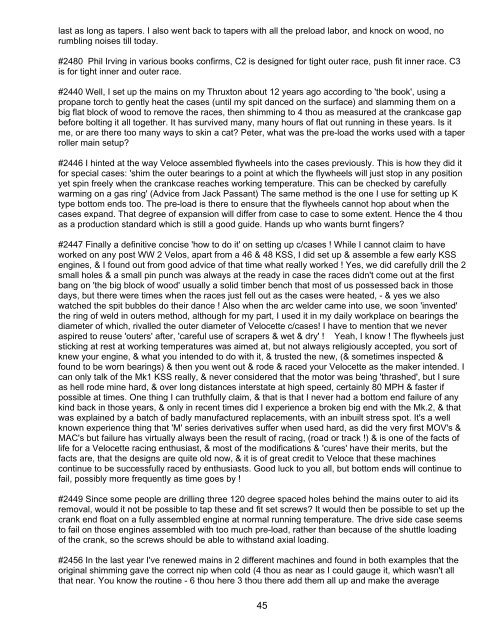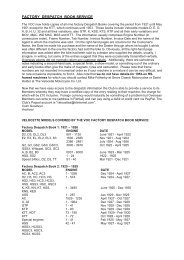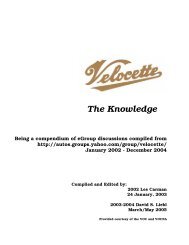The Knowledge - Velocette Owners Club
The Knowledge - Velocette Owners Club
The Knowledge - Velocette Owners Club
You also want an ePaper? Increase the reach of your titles
YUMPU automatically turns print PDFs into web optimized ePapers that Google loves.
last as long as tapers. I also went back to tapers with all the preload labor, and knock on wood, no<br />
rumbling noises till today.<br />
#2480 Phil Irving in various books confirms, C2 is designed for tight outer race, push fit inner race. C3<br />
is for tight inner and outer race.<br />
#2440 Well, I set up the mains on my Thruxton about 12 years ago according to 'the book', using a<br />
propane torch to gently heat the cases (until my spit danced on the surface) and slamming them on a<br />
big flat block of wood to remove the races, then shimming to 4 thou as measured at the crankcase gap<br />
before bolting it all together. It has survived many, many hours of flat out running in these years. Is it<br />
me, or are there too many ways to skin a cat? Peter, what was the pre-load the works used with a taper<br />
roller main setup?<br />
#2446 I hinted at the way Veloce assembled flywheels into the cases previously. This is how they did it<br />
for special cases: 'shim the outer bearings to a point at which the flywheels will just stop in any position<br />
yet spin freely when the crankcase reaches working temperature. This can be checked by carefully<br />
warming on a gas ring' (Advice from Jack Passant) <strong>The</strong> same method is the one I use for setting up K<br />
type bottom ends too. <strong>The</strong> pre-load is there to ensure that the flywheels cannot hop about when the<br />
cases expand. That degree of expansion will differ from case to case to some extent. Hence the 4 thou<br />
as a production standard which is still a good guide. Hands up who wants burnt fingers?<br />
#2447 Finally a definitive concise 'how to do it' on setting up c/cases ! While I cannot claim to have<br />
worked on any post WW 2 Velos, apart from a 46 & 48 KSS, I did set up & assemble a few early KSS<br />
engines, & I found out from good advice of that time what really worked ! Yes, we did carefully drill the 2<br />
small holes & a small pin punch was always at the ready in case the races didn't come out at the first<br />
bang on 'the big block of wood' usually a solid timber bench that most of us possessed back in those<br />
days, but there were times when the races just fell out as the cases were heated, - & yes we also<br />
watched the spit bubbles do their dance ! Also when the arc welder came into use, we soon 'invented'<br />
the ring of weld in outers method, although for my part, I used it in my daily workplace on bearings the<br />
diameter of which, rivalled the outer diameter of <strong>Velocette</strong> c/cases! I have to mention that we never<br />
aspired to reuse 'outers' after, 'careful use of scrapers & wet & dry' ! Yeah, I know ! <strong>The</strong> flywheels just<br />
sticking at rest at working temperatures was aimed at, but not always religiously accepted, you sort of<br />
knew your engine, & what you intended to do with it, & trusted the new, (& sometimes inspected &<br />
found to be worn bearings) & then you went out & rode & raced your <strong>Velocette</strong> as the maker intended. I<br />
can only talk of the Mk1 KSS really, & never considered that the motor was being 'thrashed', but I sure<br />
as hell rode mine hard, & over long distances interstate at high speed, certainly 80 MPH & faster if<br />
possible at times. One thing I can truthfully claim, & that is that I never had a bottom end failure of any<br />
kind back in those years, & only in recent times did I experience a broken big end with the Mk.2, & that<br />
was explained by a batch of badly manufactured replacements, with an inbuilt stress spot. It's a well<br />
known experience thing that 'M' series derivatives suffer when used hard, as did the very first MOV's &<br />
MAC's but failure has virtually always been the result of racing, (road or track !) & is one of the facts of<br />
life for a <strong>Velocette</strong> racing enthusiast, & most of the modifications & 'cures' have their merits, but the<br />
facts are, that the designs are quite old now, & it is of great credit to Veloce that these machines<br />
continue to be successfully raced by enthusiasts. Good luck to you all, but bottom ends will continue to<br />
fail, possibly more frequently as time goes by !<br />
#2449 Since some people are drilling three 120 degree spaced holes behind the mains outer to aid its<br />
removal, would it not be possible to tap these and fit set screws? It would then be possible to set up the<br />
crank end float on a fully assembled engine at normal running temperature. <strong>The</strong> drive side case seems<br />
to fail on those engines assembled with too much pre-load, rather than because of the shuttle loading<br />
of the crank, so the screws should be able to withstand axial loading.<br />
#2456 In the last year I've renewed mains in 2 different machines and found in both examples that the<br />
original shimming gave the correct nip when cold (4 thou as near as I could gauge it, which wasn't all<br />
that near. You know the routine - 6 thou here 3 thou there add them all up and make the average<br />
45





